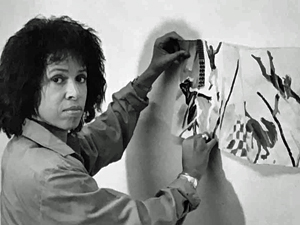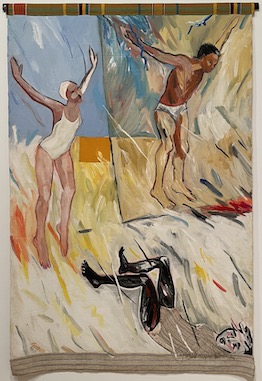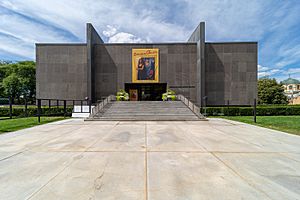Emma Amos (painter) facts for kids
Quick facts for kids
Emma Amos
|
|
|---|---|

Amos in her studio in the 1990s
|
|
| Born | 16 March 1937 Atlanta, Georgia, US
|
| Died | 20 May 2020 (aged 83) |
| Nationality | American |
| Education |
|
| Known for | Postmodernist African-American painter and printmaker |
| Style | She combines printmaking, painting and textile in her works, usually on linen and large and unframed. |
Emma Amos (born March 16, 1937 – died May 20, 2020) was an important African-American painter and printmaker. She was known for her unique style that blended different art forms.
Contents
Early Life and Art Dreams
Emma Amos was born in Atlanta, Georgia, in 1937. From a very young age, she loved art. She would make many paper dolls and learned to draw people by looking at magazines. By age nine, she was already painting figures. Her mother hoped she could study with a famous artist named Hale Woodruff, but he moved away before Emma had the chance.
When she was eleven, Emma took an art class at Morris Brown College. There, she improved her drawing skills and saw the amazing art that older African American college students were creating. By the time she was in high school, Emma was showing her artwork in local art shows. She finished high school at 16 and chose to go to Antioch College because it had very modern ideas.
Her father made sure she met many smart black thinkers. Famous writer Zora Neale Hurston often visited their home, and civil rights leader W.E.B. Du Bois even stopped by once.
Education and Learning New Skills
Emma Amos studied at Antioch College in Ohio, the Central School of Art and Design in London, and New York University. At Antioch, she worked for half the year and studied for the other half. She worked in cities like Chicago and New York, which allowed her to visit art galleries and museums. These places were harder to access back in Atlanta.
During her fourth year at Antioch, she went to England. At the London Central School of Art, she learned how to make prints and etchings. She also started painting with oils, which was new for her. Emma earned her first degree from Antioch in 1958. Then, she went back to London for two more years to get a degree in etching in 1959. The next year, she moved to New York City to work in printmaking studios. Later, she earned her master's degree from New York University (NYU).
Starting Her Art Career
After moving to New York City, Emma Amos faced many challenges. It was hard for her to get her art shown in galleries or find teaching jobs. She felt that galleries wouldn't accept her because she was too young. Teaching jobs often turned her down, saying they weren't hiring.
She eventually taught as an assistant at the Dalton School. There, she met other artists and learned about the art scene in New York. It was also around this time that Emma Amos began designing textiles, creating unique carpets for a famous weaver named Dorothy Liebes.
In New York, Emma joined printmaking studios. Even though it was often difficult for African American artists to get their work seen, Emma kept going. She earned her master's degree from New York University in 1966. While at NYU, she reconnected with Hale Woodruff, who was a professor there.
When Emma was 23, Woodruff told her about a group called Spiral. This group was started in 1963 by about fifteen important African American artists, including Romare Bearden and Hale Woodruff. They discussed ideas about black identity and how art could reflect it. Woodruff showed some of Emma's work to the group, and they liked it so much that they invited her to join. She became their first and only female member.
Emma felt joining Spiral would be helpful because she didn't know many artists in New York. She worked full-time as a designer during the day, studied in the evenings, and painted on weekends. In 1965, Spiral held their first and only art show. Emma displayed an etching called Without a Feather Boa, which is now lost. Before joining Spiral, Emma wasn't sure about art shows that only featured work by African Americans. But she learned that these were often the only chances black artists had. She also learned how to put ideas about race and gender into her art without it becoming only about politics.
The Spiral group stopped meeting after 1965 because they lost their meeting space. In the 1970s, Emma Amos taught textile design and became a successful weaver. Weaving and fabric art became very popular during the Feminist Art Movement.
Emma also created and co-hosted a crafts show called Show of Hands for a TV station in Boston from 1977 to 1979. Later, she became a Professor at the Mason Gross School of the Arts at Rutgers University.
She designed a memorial for Ralph David Abernathy, a civil rights leader. This memorial is made of four art pieces and is in Ralph David Abernathy Memorial Park in Atlanta, Georgia. Her artwork Measuring Measuring (1995) was even used on the cover of a history book about African American women artists.
Her Unique Art Style

Emma Amos was known for combining different art forms in her work. She often used printmaking, painting, and textiles together. Her artworks were usually large, unframed, and often showed herself or her experiences. She used acrylic paint, etching, silkscreen, and even transferred photos onto fabric. She also used African textiles in her art.
Emma often used ideas and symbols from European art but added her own twist. She would include parts of famous paintings by artists like Paul Gauguin and Henri Matisse. She showed how postmodernist art can mix different styles and techniques to create a "seamless work of art."
Besides adding African fabric borders to her paintings, Emma would also sew, appliqué, embroider, and sometimes quilt with her own woven fabrics, Kente cloth, and batiks. The large size and many layers in her work were similar to old European tapestries and art from the African diaspora (people of African origin living outside Africa).
Sharon Patton, an art museum director, described Emma's work by saying:
Emma's paintings tell stories, but they all have the same goal: to challenge old ideas in art and society. She uses her art to look closely at how culture is made, who creates it, what it means, and how people experience it. Emma is a true postmodern artist because she questions traditional art rules and institutions that have often been unfair to women and artists of color, especially black artists.
Emma's main subject in her mixed-media art was often people.
While studying art, Emma also explored abstract painting, which uses shapes and colors instead of real objects. For a while, she created Abstract Expressionist art. But she later felt abstract art was too easy, so she went back to painting people because it was more challenging. However, the influence of abstract art remained in her figurative work.
Emma used her art to explore themes of race and gender. She believed that simply being a black artist was a political act. She pointed out that famous white male artists, like Pablo Picasso, were praised for including people of color in their art. But African American artists were often expected to only paint other people of color. Emma challenged this idea by including white subjects in her art, even images of the Ku Klux Klan.
Fighting for Feminism

Emma Amos said that growing up in the South as an African American woman, she was always aware of the difficulties she faced. However, she didn't become actively involved in Feminism until the late 1980s. Before that, in the early 1970s, she was invited to join a feminist art group in New York City. But she decided not to go. She felt that the discussions didn't include the experiences of black women, who often worked and supported their families. She said, "I felt I could not afford to spend precious time away from studio and family to listen to stories so far removed from my own."
It wasn't until the early 1980s, when she started teaching at Rutgers University, that she decided to join a feminist group called Heresies. In this group, women from all backgrounds worked together to publish art and writings by unknown women artists in magazines and discussions. Emma said about the group, "All of my dislike for white feminists disappeared, because we were all in the same boat. We just came to the boat from different spaces." She helped edit the group's journal, Heresies: A Feminist Publication on Art and Politics.
Emma Amos was also a secret member of the feminist group Guerrilla Girls, using the fake name Zora Neale Hurston. She was also briefly involved with A.I.R. Gallery, which was the first art gallery run by women in the United States. For many years, Emma also attended meetings with a group called Fantastic Women in the Arts. This group also looked at the art and writings of many female artists. They also discussed how the changes in the 1960s and 1970s about racism and sexism didn't really help black Americans or women. In this group, Emma talked about how some artists had an easier time because of their background, and how this was clear in the art world and everyday life. Emma stayed active in these issues and taught younger generations. She hoped to see more changes soon.
Legacy and Impact
Emma Amos stopped teaching in 2008. She made sure to visit her students' art shows to support them. Her artworks shown in the 2017 Soul of a Nation exhibit at the Tate museum even inspired a fashion collection by designer Duro Olowu.
Emma Amos passed away on May 20, 2020, at the age of 83, due to complications from Alzheimer's disease. In 2021, an art show called Emma Amos: Color Odyssey opened. It showed many of her works and traveled to different museums.
Her work was also part of the 2022 exhibition Women Painting Women at the Modern Art Museum of Fort Worth.
Notable Works in Public Collections
- Without Feather Boa (1965), Cleveland Museum of Art; Museum of Modern Art, New York; and Whitney Museum, New York
- Baby (1966), Whitney Museum, New York
- Flower Sniffer (1966), Brooklyn Museum, New York
- Godzilla (1968), Munson-Williams-Proctor Arts Institute, Utica, New York
- Summer, 1968 (1968), Minnesota Museum of American Art, Saint Paul
- 3 Ladies (1970), Art Institute of Chicago; Museum of Modern Art, New York; and Philadelphia Museum of Art
- Sandy and Her Husband (1973), Cleveland Museum of Art
- American Girl (1974), British Museum, London; Library of Congress, Washington, D.C.; Museum of Modern Art, New York; Philadelphia Museum of Art; and Smithsonian American Art Museum, Smithsonian Institution, Washington, D.C.
- Dream Girl (1975), Museum of Fine Arts, Houston
- Pool Lady (1980), National Gallery of Art, Washington, D.C.
- Sand Tan (1980), Library of Congress, Washington, D.C.
- To Sit (With Pochoir) (1981), Baltimore Museum of Art; Philadelphia Museum of Art; and Princeton University Art Museum, Princeton, New Jersey
- Out in Front (1982), Minneapolis Institute of Art
- Winning (1982), Smithsonian American Art Museum, Smithsonian Institution, Washington, D.C.
- Black Dog Blues (1983), Art Institute of Chicago
- Take One (1985-1987), Museum of Modern Art, New York
- Equals (1992), Detroit Institute of Arts
- Mississippi Wagon 1937 (1992), British Museum, London
- Baggage (1993), Wadsworth Atheneum, Hartford, Connecticut
- Reminders GA & FL (1994), Williams College Museum of Art, Williamstown, Massachusetts
- Sold (1994), Whitney Museum, New York; and Yale University Art Gallery, New Haven, Connecticut
- Tightrope (1994), Minneapolis Institute of Art
- About Whiteness (Red) (1995), Whitney Museum, New York
- Measuring, Measuring (1995), Birmingham Museum of Art, Alabama
- Solo (1999), San Francisco Museum of Modern Art
- Crown (2002), Minneapolis Institute of Art; National Gallery of Art, Washington, D.C.; and Princeton University Art Museum, Princeton, New Jersey
- Miss Otis (2002), Philadelphia Museum of Art; and Telfair Museums, Savannah, Georgia
- How Time Flies (2004), Mount Holyoke College Art Museum, South Hadley, Massachusetts; and National Gallery of Art, Washington, D.C.
- Identity (2006), Museum of Modern Art, New York; Smith College Museum of Art, Northampton, Massachusetts; and Zimmerli Art Museum at Rutgers University, New Brunswick, New Jersey
See also
 In Spanish: Emma Amos para niños
In Spanish: Emma Amos para niños

